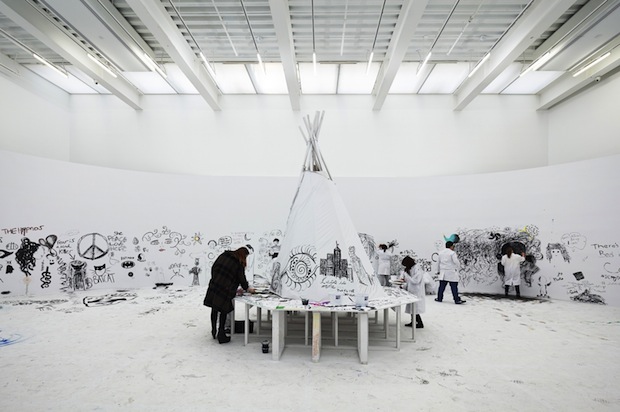Is Pawel Althamer the art world version of a Manic Pixie Dream Girl, the charmingly delirious, but emotionally superficial female character trope of Amelie, Annie Hall, or Garden State? I wondered this at the New Museum, in his twinkling three-story solo show of figurative sculpture and videos, all celebrating the minutia of daily life. Video upon video reveals Althamer’s seemingly bottomless sense of wonder: footage of the artist smelling the flowers, watching and marvelling at every passing duck, leaf, stick, and pedestrian. “Oh a hat!” “Oh, a little Snow White!”, he exclaims. After a while, you begin to realize that childlike fascination is the show’s whole selling point. It’s the main theme in the text, like the label accompanying Self Portrait as a Billy Goat, a sculpture of the Polish character Matołek the Billy Goat, and Althamer’s double identity on his journeys around the world. “The figure represents the spirit of exploration and discovery that is characteristic to the artist’s approach to art and life,” we’re told, “viewing the disparate figures he creates as totems in which viewers can recognize themselves as well as find community.”
Supposedly, Althamer’s special view of the world gives him an extra level of interpersonal insight. That’s where the show becomes a little hard to swallow. For all of its good intentions, I left the exhibition with the sense that I’d just waded through a big stew of canned feelings.
Those are largely due to Althamer’s own brand of magical mythology, which tries to reconstruct the purity of children. In the video series So-Called Waves and Other Phenomena of the Mind (2003-04), Althamer regresses to ancient or childhood memories through hypnotism while tripping on psychedelics. Nearby, there’s a video of himself playing with his daughter in the park, as a peer. Another animation Mezalia shows a man reminiscing about two boys and their toy boat (sauced with stock violin soundtrack and faux-distressed film filter). Children don’t know anything, and that makes their world a better place.
This may sound like Darger-level weird. But while dark adult realities always lurk beneath Darger’s babies, Althamer’s approach is more to laugh off ugly realities, viewing them with the blissfully short attention span of children.
To be fair, “The Neighbors” acknowledges some of those issues, in its overwhelming desire to include people outside art world walls; much of Althamer’s work was made in collaboration with sufferers with MS, the poor, and children with learning disabilities. The New Museum show comes with a coat drive, which was badly needed; arts institutions, which so often stand for gentrification, should be more aware of their communities. We had a severe winter this year, and New York Cares had a shortage of coats.
But when it comes time for Althamer to offer some reflection on neighbors, you get less insight than similarities. What, for example, do we learn about the people of Venice, from the sculptures of Venice residents, which Althamer made for last year’s Biennale? Each individual looks more or less the same; for some reason, they all come with skeletal, ribbon bodies and nonspecific postures. The vague specters give off a sense of blanket anguish, but not a particularly deep insight into the lives of others. (It echoes habits of another successful European artist, Juan Muñoz, or Chinese artist Ai Weiwei: if the figure doesn’t say much on its own, then multiply by 100). The same goes for Draftsmen’s Congress, where Althamer’s invited New Museum visitors to draw on the walls of the fourth floor gallery. The piece looks pretty much how you’d expect. It’s covered in museumy doodles like “$ < <3.”
The most detailed sculpture (a collaboration with children with learning disabilities) commemorates a homeless man nicknamed Guma (or “rubber”), for his tendency to rock back and forth. “Guma is one of a number of sculptures that Pawel Althamer has created to celebrate individuals on the margins of society,” the wall text reads. “These works are monuments to men and women who are often overlooked but remain members of the community…” But the result is a sketch; Althamer installed Guma outside his favorite bar, on a set of springs so he can sway back and forth as he did in life. You don’t see a picture of an individual, so much as the idea of alcoholism.
By contrast, look at the range of Martha Wilson’s portraits of herself masked as other people. Wilson has spoken about breaking habits in order to to express exactly what she’s trying to convey; she stopped herself from composing her self-portraits in mirrors because her own “feedback” was getting in the way of the expression she’s trying to create in her work. Wilson creates images of herself. Oddly, “The Neighbors” feels much more like a mirror.
But as “The Neighbors”’s title suggests, art could simply be located in Althamer’s gesture of collaboration alone, which can be seen as a method of exploring spiritual beliefs. Althamer has said that his body is a portal for a “wiser self”, which he accesses through psychedelic drugs and hypnotism (as documented in the artist’s videos). Those beliefs seem to have extended to the notion that people can magically control the universe around them. Althamer has been quoted in an interview with Adam Szymczyk that misfortune is a choice: “I went so far as to ask the Nowolipie Group whether they thought they’d caused their illness themselves, whether they’d wanted to become ill.”
It’s an example of how Althamer chooses to simplify the world to the extent that it loses its connection with reality. Thinking like children might make for more personal sensitivity, but the world is big, and people are complicated.




Comments on this entry are closed.